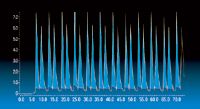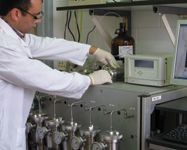Supercritical Fluid Chiral Separations
The combination of supercritical fluid chromatography with chiral separation media offers several analytival advantages over traditional liquid chromatography techniques.
By itself, supercritical fluid chromatography (SFC) is a well-known technique in pharmaceutical laboratories. Combined with chiral separation media, however, the technique can prove to be a powerful tool for reducing early-phase development costs and time. Although SFC chiral chromatography can be used at a process scale, its most typical application involves separating 50–100 g of materials for toxicology studies during the discovery and preclinical stages (see Figure 1).

(REGIS TECHNOLOGIES)
Regis Technologies manufactures chiral stationary phases and performs SFC custom separation work using chiral stationary phases under good manufacturing practices (GMP).

Figure 1: Preparative separation using supercritical fluid chromatography.
"We work with a lot of companies that are just starting in their own process and looking for drugs to market," says Francis Mannerino, director of chromatography at Regis Technologies (Morton Grove, IL). "We see compounds in their earliest stage and a lot of them have difficulties in their purification. If they have a chiral separation built in, we try to marry the custom synthesis with the separation work or the purification work."
Better business, better science
The method development for SFC chiral chromatography is similar to that for a typical liquid chromatography (LC) technique. SFC chiral chromatography uses the same columns that are used in LC and the same, readily available stationary phases (see Figure 2). Only the carrier is different. LC requires the use of 100% solvent, such as hexane–isopropyl alcohol (IPA) mobile phase. In SFC chiral chromatography, CO2 liquid is the main carrier with a 5–10% cosolvent added with it. Most cosolvents are hexane, IPA, methanol, and ethanol. About 95% of the separations by LC also can be separated with the SFC chiral method and, in some cases, the resolution can be improved over traditional LC results.

Figure 2: Scientist using an SFC preparative instrument in the Regis Separations laboratory.
According to Mannerino, there are two main business advantages of SFC chiral chromatography: separations can be completed at least five times faster than separations using traditional LC and the technique uses about one-tenth of the amount of solvent, which reduces process costs and produces less hazardous waste.
"What it comes down to is speed. Getting your drug to toxicology testing faster. If you're going to fail, fail fast. Take your resources and put them into another project," says Mannerino.
The GMP road
As the first company performing SFC chiral separations under GMP, Regis faced several challenges. "For any new technique, qualifying for GMP is very trying,"says Mannerino. Fortunately, the company manufactures active pharmaceutical ingredients and finished-drug products under GMP conditions, so there were quality systems already in place. "We just needed to make the capability GMP, so it was about 40 or 50 new standard operating procedures, and we customized them for SFC equipment and personnel."
After about 10 months and several dry runs, the company gained GMP qualification. "Our challenge right now on the research side is improving productivity. There are no precedents, so we are developing different methods such as putting columns in series and using different phases in series," says Mannerino.
Increasing productivity is crucial for shortening cycle time. SFC separation is a continuous process. Once automated systems are developed and the technique is optimized, machines can run all day. "If you want a technique for commercial use, you have to optimize it as much as you can. That's the biggest challenge now:increasing productivity by doing the research," says Mannerino.
In progress
Productivity will play a big role in future advances in SFC chiral methods. Much of the problem in progressing the technique stems from the fact that a lot of SCF work so far has been conducted with proprietary compounds and information is not available.
Regis scientists are conducting studies involving different chiral phases from two manufacturers, with one column in a series being used for mixing. "I think the biggest improvements will come in the machinery. Advances in the machinery and feedback from companies will move the technology forward," says Mannerino. "When a manufacturer does research, it a completely different story than when it is done in other settings. We are in constant communication with equipment manufacturers."
As with any chromatographic technique, continued compliance with US Food and Drug Administration regulations is an issue. For this reason, the approval of SFC chiral methods is another important factor in its success. "A validated synthesis will always be favorable over a chromatographic technique, even when it doesn't make sense financially or scientifically,"says Mannerino. Perhaps the greatest obstacle, however, is convincing high-level personnel. "It's just fighting old-school thinking,"he says. have a lot of upper management in companies that didn't grow up with advanced chromatography techniques, and they didn't go to school or internships with it. There are so many variables that you can't explain in chromatography, and so in their eyes it's not a reliable technique. Many organic chemists won't buy into it. It's changing slowly."
This article is based on an interview with Francis Mannerino, director of chromatography at Regis Technologies (Morton Grove, IL).
PacBio Chosen as Tech Partner for Global Alzheimer’s Disease Research Project
April 23rd 2025The project, the North African Dementia Registry, will unite multiple entities for the purpose of developing a comprehensive dataset to advance the research community’s understanding of Alzheimer’s disease and other dementias in diverse populations.
Drug Solutions Podcast: A Closer Look at mRNA in Oncology and Vaccines
April 30th 2024In this episode fo the Drug Solutions Podcast, etherna’s vice-president of Technology and Innovation, Stefaan De Koker, discusses the merits and challenges of using mRNA as the foundation for therapeutics in oncology as well as for vaccines.
